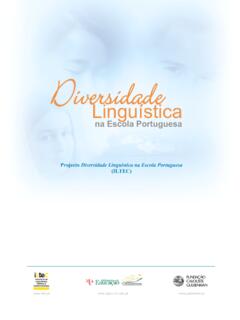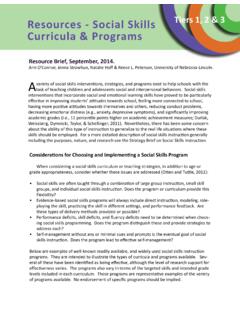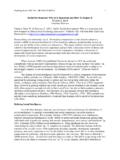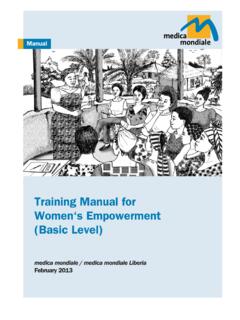Transcription of Principles and Procedures of Materials Development for ...
1 Principles and Procedures of Materials Development for Language Learning Brian Tomlinson This paper takes the position that language learning Materials should ideally be driven by learning and teaching Principles rather than developed ad hoc or in imitation of best selling coursebooks. It briefly reviews the literature which contributes positively towards the principled Development of ELT Materials and comments on its implications for Materials writing. It then presents six Principles of language acquisition which the author thinks should be given a lot more attention in Materials Development . It outlines and justifies each principle and then derives from it Materials Development Principles and Procedures which teachers and Materials writers could apply to the actual Development of Materials .
2 1 Introduction In recent years there have been a number of insightful publications which have concerned themselves with how authors typically write ELT Materials (for example, Prowse 1998). As Tomlinson (forthcoming 2010) says, this literature reveals that many experienced authors rely on their intuitions about what works' and make frequent use of activities from their repertoire which seem to fit with their objectives. Very few authors are actually guided by learning Principles or considerations of coherence and many seem to make the assumption that clear presentation and active, relevant practice are sufficient to lead to acquisition. My position is that Materials should not be random recreations from repertoire nor crafty clones of previously successful Materials .
3 Instead they should be coherent and principled applications of: i) theories of language acquisition and Development ii) Principles of teaching iii) our current knowledge of how the target language is actually used iv) the results of systematic observation and evaluation of Materials in use. This is the position which drives this chapter. In it I will focus in particular on applications of theories of language acquisition. 2 Review of the Literature In this section I will briefly review some of the literature which I think contributes positively towards the principled Development of ELT Materials . In Hidalgo et al (1995) there are a number of writers from South-East Asia who articulate principled approaches to Materials Development reflecting how they think learners learn languages.
4 Some of them propose frameworks and many list the Principles which drive their Materials . Tomlinson (1998: 5-22) proposes fifteen Principles for Materials Development which derive from second language acquisition research and experience. Of these I would focus on the following six as those which should drive ELT Materials Development : The Materials should: Expose the learners to language in authentic use Help learners to pay attention to features of authentic input Provide the learners with opportunities to use the target language to achieve communicative purposes Provide opportunities for outcome feedback Achieve impact in the sense that they arouse and sustain the learners' curiosity and attention Stimulate intellectual, aesthetic and emotional involvement A number of other writers outline principled approaches to developing ELT Materials in Tomlinson (1998) as do many writers in Tomlinson (2003).
5 McGrath (2002: 152- 161) reviews the literature on principled approaches, frameworks and Procedures for units for Materials Development , as does Tomlinson (forthcoming 2010), and Tomlinson (2008) proposes ways of applying commonly agreed theories of language acquisition to Materials Development . 3 Proposals for Principled Approaches to the Development of ELT. Materials One of the things which Materials writers need to do is to develop flexible frameworks to help them produce effective Materials for target learners in principled and coherent ways. This is something I always do before embarking on a Materials Development project. My framework develops as I progress and it helps me to write quickly and effectively. But before such frameworks are developed the writers need to decide what Principles should drive their Procedures .
6 Here are the main Principles of language acquisition which I follow when developing Materials , and some of the Principles for Materials Development which I derive from them. As you read them you might like to evaluate their validity and usefulness and to think of other Principles of your own. Principle of Language Acquisition 1. A pre-requisite for language acquisition is that the learners are exposed to a rich, meaningful and comprehensible input of language in use. In order to acquire the ability to use the language effectively the learners need a lot of experience of the language being used in a variety of different ways for a variety of purposes. They need to be able to understand enough of this input to gain positive access to it and it needs to be meaningful to them (Krashen 1985).
7 They also need to experience particular language items and features many times in meaningful and comprehensible input in order to eventually acquire them. Each encounter helps to elaborate and deepen awareness and to facilitate the Development of hypotheses needed for eventual acquisition. Principles of Materials Development 1 Make sure that the Materials contain a lot of spoken and written texts which provide extensive experience of language being used in order to achieve outcomes in a variety of text types and genres in relation to topics, themes, events, locations etc likely to be meaningful to the target learners. 2 Make sure that the language the learners are exposed to is authentic in the sense that it represents how the language is typically used.
8 If the language is inauthentic because it has been written or reduced to exemplify a particular language feature then the learners will not acquire the ability to use the language typically or effectively. Much has been written on the issue of authenticity and some experts consider that it is useful to focus attention on a feature of a language by removing distracting difficulties and complexities from sample texts. My position is that such contrived focus might be of some value as an additional aid to help the learner to focus on salient features but that prior and subsequent exposure to those features in authentic use is essential. 3 Make sure that the language input is contextualised. Language use is determined and interpreted in relation to its context of use.
9 De-contextualised examples do not contain enough information about the user, the addressee(s), the relationships between the interactants, the setting, the intentions or the outcomes for them to be of value to the language learner. I can, for example, think of at least three different interpretations of, Give him the keys. Let him drive it. But I do not know what it really means nor why the speaker has used the imperative until I know who is saying it, who they are saying it to, what the relationship between them is, where they are, what has happened before and what the objectives of the conversation are. Only extended samples of language in contextualised use can provide learners with the information' they need to develop awareness of how the target language is actually used.
10 4 Make sure that the learners are exposed to sufficient samples of language in authentic use to provide natural re-cycling of language items and features which might be useful for the learners to acquire. Examples of Materials I use what I call task-free activities to help me to apply Principle of Language Acquisition 1. This involves me at the beginning of every lesson reading a poem or story, or telling a joke or anecdote. There are no questions or tasks after the listening, just written copies of the text for those students who were engaged by it to take home, read and file away. The students are encouraged to ask me questions about the texts at any time and to return to read the texts they have collected many times. I also use extensive reading, extensive listening and extensive viewing to help to apply this principle and I use a text-driven approach to developing units of material in which an extensive text drives the skills and language activities of each unit.









